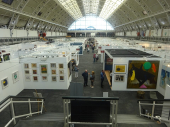
The results are in of a battle that pitted London's culture vultures against a Chinese workshop churning out replicas of the world's most famous paintings, revealing a clear victory for the cut-price masters.
For nearly three months, visitors to London's Dulwich Picture Gallery have pored over 270 paintings in its permanent collection, including works by Rembrandt, Rubens and Gainsborough, knowing that there was one $120 (109-euro) fake in their midst.
Around 3,000 people voted for their pick of the replica, but only 300 correctly identified it as French artist Jean-Honore Fragonard's 18th century portrait "Young Woman".
"The white looks too bright and fresh," said visitor Emma Hollanby, as she looked at the two paintings side-by-side, depicting an unknown woman with rouged cheeks and red lips, peering seductively at the viewer.
"But it's easy to say when it's next to it (the original), and I probably wouldn't have got it," admitted the 26-year-old, who works in a gallery.
The experiment was the brainchild of American artist Doug Fishbone, who wanted to "throw down the gauntlet" to museum-goers and make them look more closely at the great works.

Chief curator Xavier Bray said he chose the Fragonard painting as "it's one of our great pictures, but tends to be something that doesn't engage".
The replica was ordered from Meisheng Oil Painting Manufacture Co. Ltd in Xiamen, in China's southeastern Fujian province.
The gallery emailed a jpeg of its chosen picture, paid $126 including shipping via PayPal, and received the rolled-up replica within three weeks by courier.
Bray called the response to the gallery's spot-the-fake challenge "very gratifying" and said it had boosted visitor numbers.
"People have been actually looking at the pictures," he told AFP. "Rather than looking at the label first and then the picture, they did the opposite."
He added that children had been particularly engaged.
"They don't seem to have that mindset that makes them think what an Old Master should look like, they go straight for what looks different," he explained.
- 'Magical quality' -
On cue, a group of young schoolchildren gathered to play a highbrow game of spot the difference.
"That one's not the fake one because it's browner, it looks older," said one, followed by a classmate, who noted that the fake was "all white and brighter".
As well as examining the type of canvas used, how it was prepared, the brushwork and what type of pigments and varnish were employed, the experts rely on the artist's innate creativity to identify the fakes.
"The original is almost what a magician would paint," said Bray. "You look at this (the fake). It's industrial and the expression is empty."
Painter Jane Preece, a regular visitor, said she would have recognised the fake because "I've always loved that painting".
"It's dark but shines through, it has a luminous quality about it," explained the 75-year-old.
"Whereas the fake just looks wrong, it hasn't got that magical quality."
The ultimate aim of the experiment, Bray said, was to give a "kick of life" to the old collection.
"In this country we take for granted a lot of the great art that we are surrounded by," he said. "It was part of my intention to make people realise how lucky they really are." AFP


































